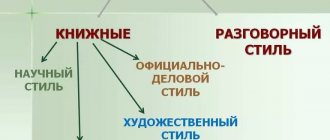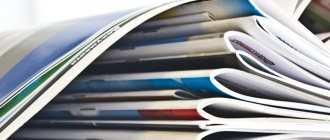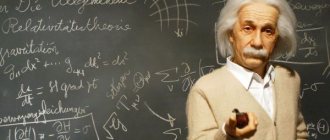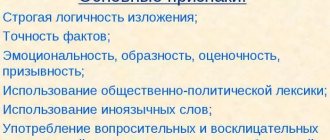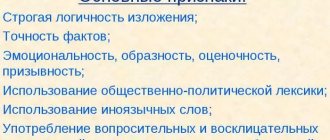In the article you will learn about what a journalistic style is and its main functions, what are the characteristic features and features of a journalistic style of speech, get acquainted with the three genres of journalistic style and at the end of the article you will find interesting information about the criteria by which media news is selected.
Not so long ago, people could only get news from local newspapers, radio and television. Now we have access to any information in any format 24/7 (thank you, Internet!).
Methods of obtaining information have changed, but the principles and features of journalism have remained the same.
Example of journalistic style text
“What an amazing discovery! A resident of the village of Lyamkino, which is located in the northern part of Russia, came up with and invented a unique remedy that allows potato tubers to grow up to 7 kg! Scientists spent many centuries thinking about the question “how to feed a large family?”, and our compatriot found the answer!
The inventor is still in great shock from his experiment and has not yet commented. But we can definitely say that such discoveries are a big step towards eliminating hunger in many countries!”
What is a journalistic style of speech?
The main goal of journalism is to provide reliable scientific facts, information about current events, and influence the audience.
The human community cannot exist without verbal communication.
We use speech patterns not only when interacting with each other, but also to convey information to people who are far away from us, both in distance and in time space.
Thus, speech is classified into various functional styles. Each style has its own characteristics. In this article we will talk about the journalistic style of speech.
This style is inherent in the written component of speech and is the official style of the media, as well as conveying important socio-political information through speeches and encouraging listeners or readers to take active action.
Like any style of writing, journalistic has its own characteristic features. Let's look at some of the most important characteristics of journalism.
Conversational style
The conversational style is used in everyday communication between people in order to share their thoughts, feelings, information, express their motives, etc. The conversational style functions in everyday life: at home, on the street, in a store, at work between employees, in an informal setting.
The main function of the conversational style is the communication function, providing everyday, everyday connections between people.
Characteristic features of the conversational style: the predominance of oral speech, informality, ease, specificity, simplicity, emotionality, the use of colloquial vocabulary, often with a colloquial flavor.
Genres (varieties) of conversational style depending on the communication situation: dialogue (conversation), telephone conversation, letter, note. Recently, the conversational style has been enriched by the genre of correspondence on the Internet, by mobile phone (sms).
The usual form of implementation of the conversational style is dialogue; this style is used exclusively in spoken language. There is no preliminary selection of language material.
Where is the journalistic style used?
More recently, in order to find out some news, people received newspapers, other daily media, and watched news programs on television.
Today, access to news information has become much wider.
Almost each of us has round-the-clock access to news feeds that are covered daily on the Internet.
Moreover, we receive news in various formats. It is interesting that, no matter how we receive news - through newspapers, magazines, via the Internet, the journalism of news information itself remains unchanged, as well as the style of journalism itself and the principles of presenting fresh information.
The style we are considering is also called journalistic writing. This is a writing style that is used to communicate new information through different channels.
There are four such channels:
- news in newspapers and magazines;
- TV shows;
- radio;
- Internet.
It is worth noting that this writing style is significantly different from other styles.
When we open a newspaper or news item on the Internet, we immediately notice the uniqueness of the news style. Journalism is distinguished by its brevity; each news story has a strictly defined structure.
For example, a big, bold headline is attractive, and the first sentence or paragraph draws the reader's attention to a summary of what will follow in the article.
Journalism involves various types of information. This could be neutral news about sports or cultural life, or it could be sharp political notes.
What does journalistic style mean?
Journalism is used not only in the media, but also literary works of this style reveal true information about certain events or personalities.
In literature, journalism is usually revealed by the author through his reasoning.
While newspaper journalism conveys accurate facts on certain information.
Genres of journalistic style, such as reportage, note, interview, article, essay, feuilleton and others, stand out sharply against the background of other literary genres.
Thanks to special linguistic functions, journalistic speech has two goals:
- The first goal is aimed at accurately conveying information to listeners or readers. Such information is not only accurate, but also relevant at a certain point in time.
- the second goal is an emotional impact, that is, this style of speech helps to encourage listeners or readers on an emotional level to a certain type of action.
Perhaps this is a call for a community cleanup or a simple request not to change the channel during advertising. Yes, and this is also a journalistic style of speech.
Scientific style
The scientific style is used in the field of scientific activity in a formal setting: at lectures, seminars, conferences, symposia, colloquiums; in scientific literature.
The main function is to exchange scientific information, report scientific information, etc.
Characteristic features : formality, preparedness of speech, a combination of written and oral forms, objectivity, logic, evidence, accuracy (unambiguity), generalization, the use of special, professional vocabulary, terms, complex syntactic structures, links to sources, quotes.
Genres : scientific monograph, scientific article, scientific report, theses, dissertation, lecture, review, report, textbook, popular science work, discussion, etc.
Main substyles of scientific style
| Varieties | Actually scientific | Scientific and educational | Popular science |
| Target | Identification and description of new facts, patterns, discoveries | Teach, describe the facts necessary to master knowledge | Give an idea of science and interest the reader |
| Destination | Scientist, specialist in a given field of science | Student, future specialist | Any person interested in one or another science |
Genre originality of journalism
Journalistic works raise quite a lot of topics. Among them are everyday life, philosophy, economics, society, politics, culture, pedagogy and much more. All these questions are addressed in completely different genres, namely:
- informational The works are more reminiscent of documents (notes, reports, reports), and in design they are similar to the official business style;
- analytical. This group of journalistic style includes articles, comments, reviews and reviews. They analyze certain problems. Close to scientific style;
- artistic and journalistic - these are essays, feuilletons, sketches and pamphlets. There are tropes and figures of speech.
Functions of journalistic style
The most important functions of the journalistic style are informational and influencing.
The information function is for the author of the text to inform the largest number of readers about priority social problems, and also express his opinion regarding the announced issue.
It is characteristic of a variety of speech styles, but in the journalistic style it has unique specifics. Not only dry facts are described here, but also the thoughts and opinions of the author are included, and his mood is often conveyed.
The influencing function, as a rule, complements the informational one. The publicist not only reports on the state of affairs in society, sharing his views on what is happening, but also calls on readers to have a certain attitude and behavior regarding the issue raised. The author's tools are bias, polemics and emotionality.
News selection criteria
First of all, the journalistic style is associated with journalism and the media. News items occupy a special place in the media: they are in demand and attract the bulk of traffic. Therefore, I propose to pay attention to one very interesting point: how is a news message created and by what criteria are news “selected”?
Below you will learn about 10 criteria for selecting news:
- Relevance . The news must correspond to the needs and interests of the audience. Residents of Kyiv are not particularly useful information about the construction of a new road in the town of Mironovka.
- Timeliness . Information about the event must be fresh and appear on time; no one will read about the voting results two weeks after the elections.
- Clarity and unambiguity. Simple, understandable news is more accessible to the general public and generates more interest.
- Predictability . Significant events usually have specific dates (for example, election day, the start of the Olympic Games, the date of the football championship). Therefore, as such an event approaches, public interest increases and the news becomes more valuable.
- Surprise . On the other hand, unpredictable events and phenomena (natural disasters, catastrophes or crimes) also arouse public interest.
- Significance and scale of the event . War, elections, protests, sports games and other important events require lengthy and detailed press coverage.
- Composition . Sometimes, in order to dilute, for example, the negativity of the information flow, the editor selects news items of an opposite nature: funny incidents, love, romance, rescue, animals, adventure, risk, etc.
- Celebrities . Due to their status and recognition, news items with the participation of politicians, artists, and athletes are more often published in the media and arouse increased interest.
- Countries that occupy a leading position in the world economy and politics. A strike, natural disaster or plane crash in a developed country will immediately hit the media, but you can write about the lack of drinking water in Ethiopia later.
- Negativity . “Bad” news is more popular.
PS: Did you like the article? Share the link on social networks! Thank you very much and have a nice day.
Sources:
- A. A. Tertychny “Genres of periodical press: textbook”;
- Media ethics owl.purdue.edu
- Robert M. Knight "Journalistic Writing: Building the Skills, Honing the Craft"
How to distinguish journalistic style from artistic style?
Journalism also has such functions as communication, expression and aesthetics.
- Communicativeness implies that the author writes his text not for internal exploitation or a specific person, but for the largest number of people. It provides the opportunity for feedback, that is, a response from the addressee (discussions, letters from readers to the newspaper editor, telephone calls to the radio, etc.). Clarity, expressiveness and respect for all participants are priorities for communication.
- Expression helps the speaker express his feelings and emotions, and also reveals his personal qualities. As in a number of styles of speech, ethical standards do not allow the author to go beyond the bounds of decency. Expressing one's feelings should not be the author's main concern.
- Aesthetics implies the reliability and accuracy of information, as well as artistic description. It is not a necessary function for journalism.
Genres of journalistic style
Page 1 of 2Genres of journalistic style are certain “relatively stable thematic, compositional and stylistic types” of works” (M.M. Bakhtin), functioning in the media.
Typically there are three groups of genres:
— informational (note, report, interview, report);
- analytical (conversation, article, correspondence, review, overview, review) and
— artistic and journalistic (essay, sketch, feuilleton, pamphlet).
Information genres are characterized to a greater extent by the function of message, while analytical genres are characterized by the function of influence.
The expression of the author's origin is modified in genres. For example, the note genre does not imply an open manifestation of the author's presence, while in the reportage genre the event is conveyed through the author's perception of it. The action of the constructive principle varies in different genres. So, for example, expression increases from information materials to artistic and journalistic ones, while, accordingly, the standard decreases.
Let's consider the stylistic features of the most common genres of newspaper journalism.
Chronicle is a genre of news journalism, secondary text, which is a collection of messages stating the presence of an event in the present, near past or near future. A chronicle message is a text of one to three or four sentences with the general meaning of “where, when, what event happened, is happening, will happen.” The main indicators of time are the adverbs “today”, “yesterday”, “tomorrow”, which allow us to correlate an event with the date it was reported. The time signal can be implicit: the meaning of “just now, now, soon” is given by the genre itself, its stating content. In the same way, the indication of the place may be implicit, for example, in a chronicle of city events there is no need to mention the name of the city in each message (an expression like “Today there will be a bike ride” will be clearly understood as “will take place in our city” if the message contains one or two more sentences, a more specific indication of the location of the action may appear). The presence of an event is recorded by an existential verb in different forms (took place, will take place, open, planned, happening, going to, will gather, working, etc.). Typical formulas at the beginning of a newsreel: “Yesterday an exhibition opened in Moscow,” “Today a meeting is being held in Yekaterinburg,” “Tomorrow an opening will take place in Perm.”
A selection of newsreels is compiled on a thematic or time basis, for example: “Crime Chronicle”, “Relevant”, “Official Chronicle”, “News in the Middle of the Hour”, etc. The title very often represents the name of the section and moves from issue to issue, from issue to issue.
The chronicle genre is used in all media, i.e. in newspapers, radio and television. Announcements and conclusions of television and radio news are drawn up in the form of this genre. Ascertaining messages are often introduced into the headline complex of newspaper materials, so a newspaper page can be read as a kind of scattered chronicle recording the main current events.
Reporting - in the narrow sense of the word, is a genre of news journalism in which a story about an event is conducted (in electronic media) or, as it were, conducted (in the press) simultaneously with the unfolding of the action. In radio and television reports, all means that convey the presence of the speaker at the scene of the event are used naturally, as the only possible ones, for example: “we are in the hall of the regional museum”, “now the rescuer is attaching a ladder”, “right in front of me”, etc. In writing, the same means are used to imitate the simultaneity of an event and a story about it: this is present. verb tense combined with the perfect, such as “I see that the rescuer has already climbed to the third floor”, elliptical and one-part sentences (we are on a rocky plateau, it’s cloudy today), the author’s “I” or “we” in the meaning of “me and my companions” "
The composition of the report provides for recording the natural course of the event. However, very few events, and even then only in electronic media, are transmitted in real time from beginning to end (football match, military parade, presidential inauguration). In other cases, time has to be compressed by selecting episodes. This raises the problem of editing episodes. A complex event consisting of a number of parallel actions, such as the Olympics, is transmitted in real time as a sequence of episodes of different actions, for example: “now the Russian gymnasts are having floor exercises, they are coming out on the mat...”, “and now we are being shown the performances of the Romanian gymnasts on the uneven bars.” . In the recording, the event is also conveyed as a sequence of edited episodes; through editing, one can achieve clear emphasis on important moments of the event and expand the author’s commentary. A written text, in principle, is not capable of reflecting the entire event, so the author of the report has to present only the most striking episodes of the event, trying to convey this brightness in words by selecting the most significant details. And the greater the role of editing, the more increasing the possibility of including a detailed and extensive author’s commentary in the text, as a result of which a special type of genre may appear - analytical reporting .
Such a text is an alternation of reported fragments of the event and various kinds of commentary inserts and reasoning, which, however, should not obscure from the reader the moment of the journalist’s presence at the scene of the event. The reporter can entrust the commentary to a specialist who is a participant in the event, then the report contains an element of an interview about the current event as a whole or about its individual moments. This is an important way to dynamize the presentation, enrich the content and form of the text. With the help of linguistic means, the addressee can be involved in the presentation, for example: “we are with you now...”.
In modern journalism, a report is often called an analytical text that emphasizes the active actions of the journalist taken to clarify the issue, even if there is no attempt by linguistic means to create the effect of the speaker’s presence at the scene of the action. Such a work includes interviews with experts, presentation and analysis of documents, often with a message about how the author managed to obtain them, stories about a trip to the scene of the event, and meetings with eyewitnesses. Since the report presupposes the active actions of the author, the compositional core turns out to be event elements, although the content of the text is aimed at analyzing the problem. This technique of dynamization in presenting a problem enriches the arsenal of ways to present analytical material to the reader.
An article is an analytical genre that presents the results of a study of an event or problem. The main stylistic feature of the genre is the logical nature of the presentation, reasoning unfolding from the main thesis to its justification through a chain of intermediate theses with their arguments, or from premises to conclusions, also through a chain of secondary theses and their arguments.
In linguistic terms, at the syntax level, there is an abundance of means expressing the logical connections of statements: conjunctions, introductory words of a logical nature, words and sentences denoting the type of logical connection, such as “let’s give an example”, “consider the reasons”, etc. At the morphological level, the genre is characterized by grammatical means that allow expressing the formulation of patterns: present abstract, singular with a collective meaning, abstract nouns. At the level of vocabulary, we observe the use of terms, including highly specialized ones with explanations, as well as words naming abstract concepts. Thus, language means are used to formalize the result of the author’s analytical activity, which reveals the patterns of development of the phenomenon, its causes and consequences, its significance for the life of society.
Journalistic articles are works whose forms are varied. The main sources of variation in the form of a newspaper article are composition and stylistic orientation of the text. An article can be structured as an argument from thesis to evidence or from premises to conclusions. Compositionally, the article is enriched by various inserts in the form of vividly written episodes of the event, included as factual arguments and reasons for reasoning, or in the form of a mini-interview, which also performs an argumentative function, cf., for example, the argument “to authority.”
Articles on style orientation are especially diverse. Articles oriented towards a scientific style most often maintain this focus only in terms of the logicality of the text. The reasoning in them can be emotionally colored. In accordance with the general bookish nature of the presentation, figures of oratorical syntax appear, but not for the sake of whipping up pathos, but for the sake of emphasizing the idea. Bookish emotional and evaluative vocabulary is also included.
A focus on conversational style is widely used. At the same time, the article sharply increases the number of techniques imitating friendly, interested oral communication with the reader on a serious issue. In the syntax, constructions appear that imitate colloquial speech: non-union sentences conveying cause-and-effect relationships, colloquial-type additions. The length of sentences is reduced. The text is filled with colloquial vocabulary that expresses an emotional assessment of the subject of speech.
Analytical articles of a critical nature can combine oratorical syntax and irony, elements of colloquial syntax and reduced emotional-evaluative vocabulary, comic techniques (puns, parody of famous texts, etc.).
An essay is an artistic and journalistic genre that requires a figurative, concrete, sensory presentation of a fact and problem.
Thematically, the essays are very diverse: they can be, for example, problematic, portrait, travel, event . Since an essay is a work with a high degree of generalization of life material, the hero and the event are drawn by the author in the process of analyzing a current social problem. The text of the essay harmoniously combines vividly, expressively conveyed events, convincingly drawn images of characters and deep, evidence-based reasoning. The combination of event, subject and logical elements of essay content depends on a number of factors. First of all, it is determined by the type of composition chosen by the essayist. If an event composition is used, then the essay is constructed as a story about an event, in the presentation of which, as in a fiction story, the plot, the development of the action, the climax, and the denouement are highlighted. The author's reasoning and description of the characters interrupt the action for some time, but then the unfolding of the text again obeys the course of the event. If logical composition is used, the construction of the text is determined by the development of the author's reasoning; episodes of one event or several different events are included in the presentation as a reason for reasoning, a thesis argument, an association by similarity or contrast, etc. Occasionally, an essay uses an essayistic composition, in which the text unfolds through associations and sharp transitions from one subject of speech to another. It must, however, be taken into account that the seemingly chaotic presentation hides the purposeful development of the author’s thought, the course of which the reader must understand through the interpretation of the associative connections of text elements.
In addition to the type of composition, the type of narrator influences the combination, as well as the linguistic design of the content elements of the essay. Narration is used in third and first person form. In third person form, the narrator may act as a voiceover observer or voiceover commentator. In the first case, the event being narrated appears to the reader as occurring as if by itself, the author’s presence is revealed only indirectly - in the choice of words denoting the details of the essay world and evaluating them, in pausing the narrative to introduce formulations that reveal the journalistic concept. The narrator - voice-over commentator is more active. Without revealing himself in the form of “I,” he can energetically interfere with the action, interrupting it with retreats into the past (retrospections) or looking ahead (prospections, i.e., a statement of future events that the hero cannot yet know about). Such a narrator often comments at great length on what is happening and evaluates it.
The most diverse functions of the narrator are in the first person form. Sometimes the journalist uses the hero's "I", i.e. the essay is constructed as a story of the hero about himself. But most often the author’s “I” is used, in which the narrator acts as a textual embodiment of the real personality of the journalist. The functions of such a narrator are varied. Thus, he can act as a participant in the event, the analysis of which is the focus of the essay. What attracts journalists most of all is the form of a narrator-researcher. In this case, the basis for the composition of the essay material is a story about the study of an event, which, as a result, unfolds before the reader not as it actually happened, but in the order in which the researcher learned about it.
Thus, an essay can be constructed, firstly, as a story about a real event, which unfolds in its natural sequence or with its violation in the form of retrospections and prospections and which is interrupted or framed by the author’s reasoning, conveying the journalistic concept to the reader. In this case, the author can act as an off-screen observer, a voice-over commentator, a participant in the event, or an interlocutor of the hero talking about the event. Secondly, the essay can be structured as a story about a journalistic investigation, and in the form of a presentation of conversations with the characters, the content of documents read and thoughts on what he saw, the reader learns about the events and people who participated in them, as well as about the problem that the journalist sees in the given facts. Thirdly, the essay can be an emotionally charged discussion by a journalist about a problem. In the course of the argument, events are presented and characters are described, which allows such a reflective narrator to reveal the problem using visual material from life.
The essay is characterized by visual writing : to represent the hero and the event, specific, vivid, visual details , which in some cases are depicted as actually observed by the narrator during the research, travel, meeting with the hero, etc.
And the narrator observing, commenting, participating in the event, and exploring the situation cannot be dispassionate. Current social problems, events and people appear before the reader in the light of the author's emotional assessment, as a result of which the essay text is colored in one tone or another.
Different types of narrators structure communication with the reader differently. Presentation in the form of a third person or in the form of the hero’s “I” dispenses with direct appeal to the reader. On the contrary, the author’s “I” is most often combined with active communication with the reader, especially in the form of “we” with the meaning “I, the author, and my reader.”
Various combinations of composition types, types of narrator, tonality and ways of communicating with the reader create a great
<< Home < Previous 1 Next > Last >>
Lexical features of journalistic style
The journalistic style is characterized by socio-political terminology, as well as vocabulary that reveals moral concepts, medicine, economics, culture, and psychology. In journalism, words with the prefixes a-, anti-, de-, inter-, raz(s)- and the suffixes -i(ya), -tsi(ya), -izatsi(ya), -ism, -ist are common.
Also often there are words with roots close in meaning to the prefixes all-, general-, super-. The text is supplemented with complex and complexly abbreviated words and stable figures of speech.
Morphological features
- The predominance of present tense forms of verbs in the imperative and conditional moods.
- The use of exclamatory particles (what, how), demonstrative particles (here), intensifying particles (even, after all).
- Use of interjections.
- Application of common appeals.
- Using modals is (of course possible).
- Application of negative particles.
- The use of participles with the prefix ne- (inexhaustible).
- The use of a large number of adjectives to indicate the author’s position.
- Using verbs in the present tense.
Syntactic features or How to determine the journalistic style of speech?
In the journalistic style of speech, nouns in the genitive case are common in the role of inconsistent definition. The role of the predicate in a sentence most often goes to the verb in the form of the imperative mood and the age verb.
The authors use homogeneous members, introductory words and sentences, participial and participial phrases and complex syntactic constructions.
REFERENCE! The linguistic means of journalistic style are often represented by ready-made speech formulas that help to easily and quickly form any text.
Art style
The artistic style is the richest style of speech, because it absorbs all the others. It most clearly reflects the national language in all its diversity and richness - it becomes a phenomenon of art, a means of creating artistic imagery.
The main function is aesthetic. The artistic style, using a variety of linguistic means, creates images that evoke an emotional response in the reader’s soul, deliver aesthetic pleasure, and force empathy. Other functions: reflection, transformation of all aspects of reality, using them as an object of creativity; impact on the reader.
Varieties of artistic style: the style of a literary movement, literary school, type of literature (epic, lyric, drama), individual style of writers, poets.
Characteristic features : imagery, aesthetics, individuality, the use of stylistically colored vocabulary, visual and expressive means (tropes, figures of speech, sound writing, color painting), using means of other styles, especially colloquial.
Main genres (by type of literature): epic - novel, story, short story, sketch, short story, poem, fable; lyric - poem, poem, elegy, song, message; drama - tragedy, drama, comedy, melodrama, vaudeville, tragicomedy.
Emotional means of expressiveness in journalistic style of speech
Publicists often use figurative means, figurative meanings of words and words with a high emotional connotation. The means of emotional expression in this case are limitless.
A journalistic text becomes similar to a literary text, but in the second the main task is to create an artistic image, whereas in journalism it is to influence the audience. The authors use epithets, comparisons, metaphors, as well as rhetorical questions and appeals.
Related posts:
- Speech styles - a brief overview of all styles Different speech styles have their own functional characteristics. There are scientific, artistic,…
- What is "War and Peace" about? Summary of the novel “War and Peace” by chapters. All answers...
- Style of artistic text - concept, features People have learned to create various texts from letters, created many styles...
- Journalistic style: classification of popular genres What are the genres of journalistic style? The genres of journalistic style are certain...
Syntactic features
The syntax of the journalistic style is structured in such a way as to attract the attention of the audience and, in some cases, induce it to take certain actions. The syntactic features of the journalistic style are as follows:
- Rhetorical questions are used to show the obvious evidence of the answer to the question posed. In this case, there is a feeling of complete agreement between the public and the informant (Are we really going to tolerate this?).
- Often an informant in journalism turns to a question-and-answer form of presentation, which allows him to enliven the dialogue and avoid monotonous and dry transmission of information (What to do in this case? First, you need to contact the police).
- To enhance the effect produced or to place emphasis in a statement, repetitions are often used (He could create and create like no one else).
- Exclamatory sentences work as a call to action or create an atmosphere of solemnity (Cheer up! Happy New Year!).
- To create a special connection between the informant and the public, addresses are used (Gentlemen, comrades, Russians, etc.).
- Inversion helps to place emphasis in the message so as to convey information in descending order from the most important to the details (All the crew members of the crashed plane survived, etc.).
- Journalism often turns to such a technique as parcellation (dividing a sentence) to create a special effect (We all want to live well. Have a great job. Family. Be worthy people.).
Lexical, morphological and syntactic features of the journalistic style work together to create a unique language of journalism that attracts millions and billions of readers and listeners. To understand what a journalistic style is, it is enough to analyze a newspaper article or news report, noticing the subtleties and features of this language.


